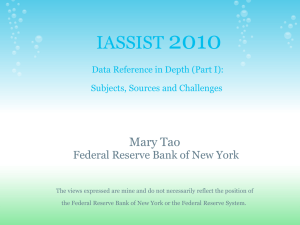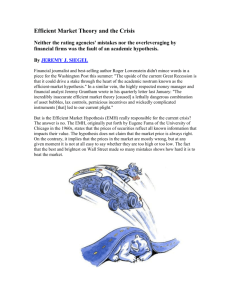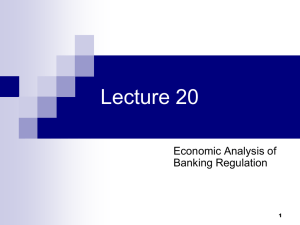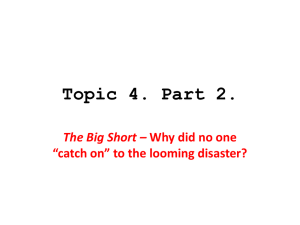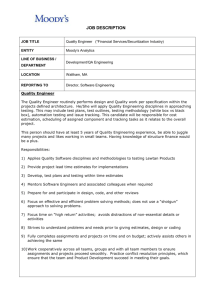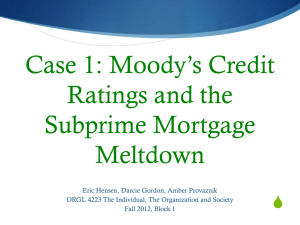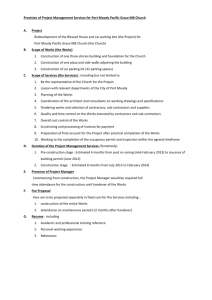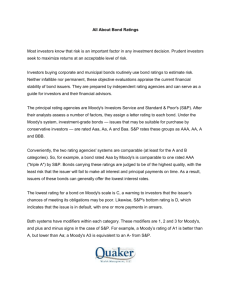Case Study - The Kenan Institute for Ethics at Duke
advertisement
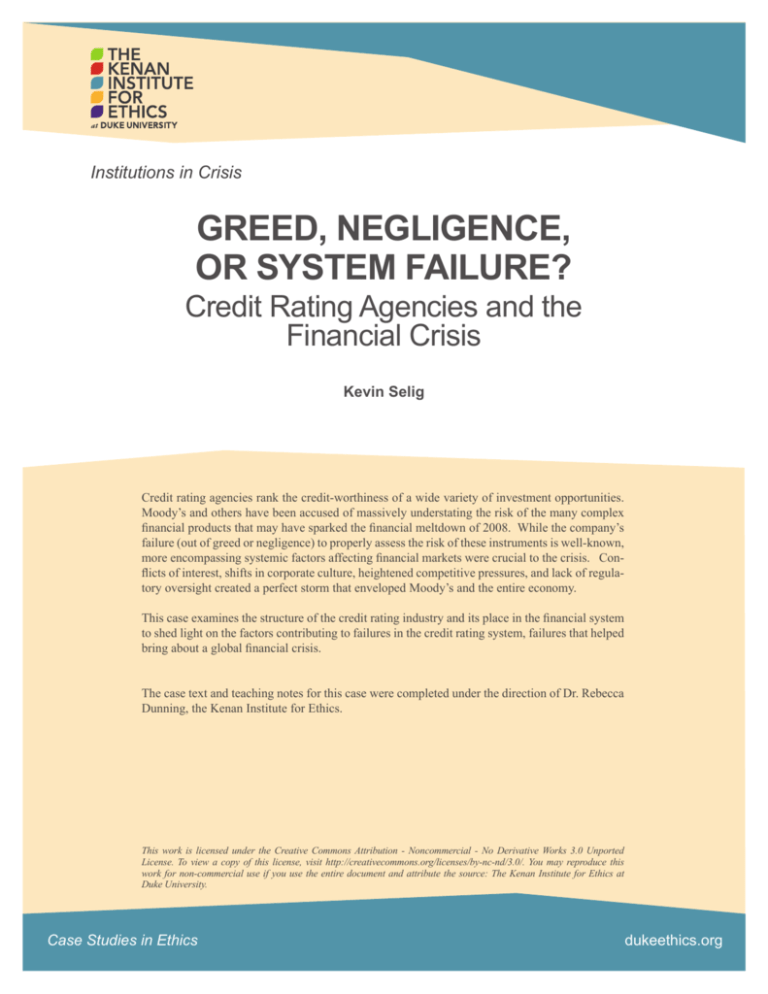
Institutions in Crisis GREED, NEGLIGENCE, OR SYSTEM FAILURE? Credit Rating Agencies and the Financial Crisis Kevin Selig Credit rating agencies rank the credit-worthiness of a wide variety of investment opportunities. Moody’s and others have been accused of massively understating the risk of the many complex financial products that may have sparked the financial meltdown of 2008. While the company’s failure (out of greed or negligence) to properly assess the risk of these instruments is well-known, more encompassing systemic factors affecting financial markets were crucial to the crisis. Conflicts of interest, shifts in corporate culture, heightened competitive pressures, and lack of regulatory oversight created a perfect storm that enveloped Moody’s and the entire economy. This case examines the structure of the credit rating industry and its place in the financial system to shed light on the factors contributing to failures in the credit rating system, failures that helped bring about a global financial crisis. The case text and teaching notes for this case were completed under the direction of Dr. Rebecca Dunning, the Kenan Institute for Ethics. This work is licensed under the Creative Commons Attribution - Noncommercial - No Derivative Works 3.0 Unported License. To view a copy of this license, visit http://creativecommons.org/licenses/by-nc-nd/3.0/. You may reproduce this work for non-commercial use if you use the entire document and attribute the source: The Kenan Institute for Ethics at Duke University. Case Studies in Ethics dukeethics.org Introduction In August of 2004, Moody’s Corporation’s Managing Director, Gary Witt, unveiled a new credit-rating model for collateralized debt obligations (CDOs). The new model relaxed many of the standards that Moody’s had used for years to assess the risk of these complex financial instruments. The move sparked a market-share war that pushed long-time competitor Standard & Poors (S&P) to make similar changes. Internally, each firm would spend the next few years experimenting with their models to ensure that they generated results that pleased their clientele so as not to lose business to competitors.1 As the subprime mortgage bubble burst and the market for CDOs dried up, however, it became apparent that Moody’s and its competitors had understated the risk the CDOs (many of which derived their value from subprime mortgages) posed to investors. The entire financial industry, which counted on the accuracy of these ratings, was affected. Many financial experts cite conflicts of interests as the major contributor to the use of rating standards that undervalued risk. As this case reveals, however, other factors, including competitive pressures, a negative shift in Moody’s corporate culture, and decades of inadequate regulatory oversight, contributed to systemic changes that negatively affected Moody’s and the entire financial industry. This case considers these factors to better understand how the organizational crisis at Moody’s and in the credit ratings sector more generally had such a devastating effect on the global financial system. Evolution of Deregulation: The Financial Industry Since 1933 The Great Depression is most often blamed on the failure of the government to adequately respond to a serious liquidity crisis.2 In 1929, a stock market crash led to a run on the U.S.’s largest banks. These banks, unable to come up with enough cash to cover the unprecedented demand for withdrawals, turned to the Federal Reserve for help. The Fed, however, cut the money supply by nearly a third, hoping to brace the American economy for the coming recession at the expense of the large banks. This action seems counterproductive to many economists today, but can be attributed to a national outcry to be tough on the large banks in hopes of promoting more fiscal responsibility in the future. However, the money supply cuts were too great for many of the struggling banks and many went under. Without the support of the large banks, smaller banks also failed, deepening the economic downturn into the worst financial depression the American economy has ever seen. Most of the lessons learned from the Great Depression could be categorized under one supposed truth: a lack of sufficient government involvement in the financial markets can lead to an out of control economy. Determined to make sure nothing like it would happen again, the American government set up a regulatory system that aimed to monitor the financial sector and control financial speculation. The Banking Act of 1933 (also know as the Glass-Steagall Act after its legislative sponsors Carter Glass and Henry Steagall) set up the Federal Deposit Insurance Corporation (FDIC) and introduced a number of other banking reforms. The Glass-Steagall Act is considered to be the high point for government intervention in the American financial markets. Glass-Steagall is a long and complicated collection of rules and principles. One of the most important 1 Smith, Elliot B. “‘Race to Bottom’ at Moody’s, S&P Secured Subprime’s Boom, Bust.”Bloomberg. 25 Sept. 2008. Web. 12 Dec. 2010. http:// www.bloomberg.com/apps/news?pid=newsarchive&sid=ax3vfya_Vtdo 2 “What Caused The Great Depression?” Investopedia. Web. 8 Dec. 2010. http://www.investopedia.com/articles/economics/08/cause-of-greatdepression.asp Case Studies in Ethics 2 dukeethics.org provisions is the separation of commercial banking from investment banking.3 Commercial banking can be described, for purposes here, as day-to-day neighborhood banking (with the exception that it occurs on a national scale). The most systemically important role of these banks is to collect and manage deposits from Main Street.4 In contrast, investment banks have traditionally used private money (a majority of which came from the banks’ owners) to speculate on many of the complex financial instruments for which Wall Street is famous. Because there was no distinction between the two types of banks before the Glass-Steagall Act, many large banks would use deposited money from Main Street to speculate on Wall Street stocks. The Glass-Steagall Act ensured that investment banks could not use Main Street money to bet on Wall Street. The assumption was that, as occurred in the late 1920’s, if those bets went sour it could lead to another nationwide run on banks. The separation between commercial and investment banks remained relatively uncontroversial through the 1940’s. World War II altered the the American economy as new trading channels increased America’s global financial presence. With the post-war economy enjoying a decade long bull-run, the American economy became the global standard of financial robustness. As the financial markets became perceived as safer, there was a push by Wall Street interests to deregulate the banking industry so as not to fetter it with bureaucracy. There are four main financial deregulatory pushes, each occurring under a different presidential administration, which occured in the late 20th and early 21st centuries: Under the Carter administration, the Depository Institutions Deregulation and Monetary Control Act (DIDMCA) loosened the standards on insurance speculation. By phasing out ceilings on interest rates, DIDMCA allowed for greater profits to be made in insurance speculation.5 Higher rates of return lead to riskier investments. The abolition of insurance rates led to an industry wide increase in competitive pressure to provide the greatest rate of return for commercial banking clients for this growing market. As banks quickly increased their profitability, market confidence in commercial banks soared. Under the Reagan administration, the Garn-St.Germain Depository Institutions Act removed restrictions on real estate lending while simultaneously relaxing limits on individual borrower lending. This Act prompted decades of increased home-ownership by the American public, the double-edged sword that would lead to the US housing bubble of the 1990s. President H.W. Bush signed into effect the Financial Institutions Reform Recovery and Enforcement Act (FIRREA) in response to multiple recessions in the 1980s.6 FIRREA also helped to boost homeownership by re-chartering Fannie Mae and Freddie Mac.7 The two government sponsored enterprises effectively work to increase the amount of loans mortgage lenders have available for borrowers.8 The most important push for deregulation came during the Clinton administration with the signing of the Financial Services Modernization Act of 1999. More commonly know as the Gramm-Leach-Bliley Act (named after its sponsors), the Act repealed most of the major provisions in the Glass-Steagall Act. No longer were insurance companies, commercial banks, and investment banks required to be separate entities. This perpetuated a trend in the early 2000s 3 Isaac, William M., and Philip C. Meyer, foreword by Paul A. Volcker. Senseless Panic: How Washington Failed America. Hoboken, NJ: John Wiley & Sons, 2010. Print. 4 “Main Street” is a term used in this case study to refer locally owned businesses or banks. “Wall Street,” in contrast, refers to big business or “Corporate America.” 5 Birger, Jon. “How Congress Set Up the Subprime Mess.” Fortune. CNNMoney.com, 30 Jan. 2008. Web. 10 Dec. 2010. http://money.cnn. com/2008/01/30/real_estate/congress_subprime.fortune/ 6 “A History of Recessions.” CNBC. Web. 8 Dec. 2010. http://www.cnbc.com/id/20510977/A_History_of_Recessions 7 Financial Institutions Reform, Recover and Enforcement Act of 1989. 101st Cong., U.S. G.P.O. (1989) (enacted). Print. 8 Semuels, Alana. “Understanding Two Loan Giants.” The Los Angeles Times. 08 Sept. 2008. Web. 15 Feb. 2011. http://articles.latimes.com/2008/sep/08/business/fi-qanda8. Case Studies in Ethics 3 dukeethics.org of consolidation among financial institutions. For example, the Gramm-Leach-Bailey Act directly allowed the 1998 merger of Citicorp and Travelers Group into the (previously illegal) banking, securities, and insurance conglomerate Citigroup.9 By allowing for these large financial firms to merge and do business, the Act effectively allowed investment banks to sell their high-risk/high-reward financial instruments to commercial banks, commercial banks that had traditionally only dabbled in low-risk/low-reward instruments. Even in hindsight, financial experts are still mixed as to whether the trend towards deregulation over the course of the century was a bad move. While it is easy to blame deregulation for the collapse of the financial system in 2008, it is important to note that deregulation buoyed the American financial system to become the global powerhouse it is today. In its most recent rankings of the world’s strongest financial markets, the World Economic Forum (WEF) ranks the U.S. financial system as the third strongest in the world (down from the first strongest in the previous rankings and now close behind Great Britain and Australia). The WEF ranked the U.S. so highly due to “its welldeveloped equity and derivatives markets, financial sector liberalization, and dominant position in merger-andacquisition activity.”10 There is another trend to note in the financial sector before moving on to looking specifically into credit rating agencies: the rise of the public corporation. Since the beginning of the 20th century, many of the most recognizable American businesses have evolved from small, privately held companies to large, publicly traded corporations. Nowhere is this more apparent than the U.S. capital markets, particularly the financial industry. This evolution can be broken down into two main trends. The first, which emerged around the turn of the century, is the corporate push towards finance capitalism. Due to the growing size and influence of America’s largest holding companies in the early 1900s, corporate management turned to outsourced bankers to take on more and more of the financial speculation and responsibility of their companies. Brought on by a wave of mergers early in the century, finance capitalism was characterized by increased profitability.11 Naturally, as the success of finance capitalism caught on, more and more corporations opted in. As the century wore on, and as Wall Street became more profitable and influential, bankers started implementing innovative and complex financial instruments that were tied tightly to corporate success and failure. Large corporations not typically linked to Wall Street began actively partaking and trading in complex financial instruments; instruments like bonds, stocks, futures, and derivatives. For the most part, these instruments further increased profitability (although they were in some cases very risky) and became more commonplace. In the 1980s, there was another wave of corporate mergers, this time in the form of takeovers. Large corporations needed a way to come up with more capital to support these ever larger businesses and turned to shareholder capitalism to fill in the accounting. The rise of shareholder capitalism can be marked by an increase in the number of corporations taking their companies public.12 No longer were investment banks like Goldman Sachs funded by the capital of their small groups of private proprietors, they could now take their companies public and benefit from the capital of countless individual investors. The definition of ownership had changed. Management could now use public funds to make investments instead of risking their own money. This further insulated large companies from risk, but at a price. Management had to show they could keep a company profitable on a quarterly basis so as to keep the company attractive to investors.13 9 Stowell, David. An Introduction to Investment Banks, Hedge Funds, and Private Equity: The New Paradigm. Burlington, MA: Academic/Elsevier, 2010. Print. 10 Liu, Leona. “Global Finance: Britain Is No. 1.” BusinessWeek. Bloomberg, 30 Oct. 2009. Web. 13 Mar. 2011. http://www.businessweek.com/ globalbiz/content/oct2009/gb20091030_040491.htm 11 Davis, Gerald F. Managed by the Markets: How Finance Re-Shaped America. New York: Oxford UP, 2009. Print. 12 Ibid. 13 Inside Job. Dir. Chris Ferguson. Sony Pictures Classics, 2010. Film. Case Studies in Ethics 4 dukeethics.org The Subprime Mortgage Crisis In order to fully understand the effect that credit rating agencies had on the global financial meltdown of 2008, it is important to understand their role in the subprime mortgage crisis. The subprime mortgage crisis is considered by many experts to be the smoking gun of the global financial crisis. There is little doubt that a collapse in the subprime market led to the crippling of key financial institutions in 2007.14 As mammoth firms like AIG, Lehman Brothers, and Bear Stearns crumpled without the capital the subprime market provided, the whole of Wall Street was affected. Experts have traced back the cause of the subprime mortgage crisis to many different factors. One of the most important of these is the inflation of the credit worthiness of the subprime market by credit rating agencies.15 Subprime Mortgages, Credit Rating Agencies, and the Financial Crisis A subprime mortgage is a mortgage that is given to an individual who would not normally qualify for a loan. Most subprime mortgages are given to homeowners who are not traditionally credit worthy.16 These individuals do not have a strong credit history. Subprime lending has been around for decades. A considerable innovation at the time of its pioneering, subprime lending permitted demographics that were previously excluded from mortgage lending (youthful homeowners, minorities, lower-middle class) to enjoy greater access to funds for buying a home. The most tangible positive effect of subprime lending is increased homeownership.17 Historically, the mortgage lender acquires all the risk of financial default if the homeowner is unable to pay the mortgage. This means that for decades lenders were extremely selective of whom they gave subprime mortgages to, as they were liable to cover the remaining debt if the mortgage defaulted. However, starting in the 1970s, several factors led to an increase in the number of subprime mortgages that were given out, an increase that would continue until the financial meltdown of 2008.18 The first of these factors is a housing market that, for the most part, continued to show long-term growth. Subprime lenders were experiencing low foreclosure rates and increasing housing prices while enjoying relatively consistent returns on their subprime investments. What put the subprime lending market into the stratosphere were new financial instruments that allowed these loans to be traded as securities. One of the chief financial instruments associated with the booming subprime market were derivatives. A derivative is a financial instrument that derives its value from the expected future value of its underlying asset. In other words, it is an agreement between two speculators that an asset is actually worth something other than that which it is currently priced.19 Underlying assets can be virtually anything, with derivatives traded on everything from stocks to oil prices to the weather. 14 Ibid. 15 White, Lawrence J. Credit Rating Agencies and the Financial Crisis: Less Regulation of CRAs Is a Better Response. Working paper. New York: Stern School of Business, New York University, 2010. 16 Ashcroft, Adam, and Til Schuermann. Understanding the Securitization of Subprime Mortgage Credit. Federal Reserve Bank of New York: Staff Report, 2008. Print. 17 Goolsbee, Austan. “‘Irresponsible’ Mortgages Have Opened Doors to Many of the Excluded.” The New York Times. 29 Mar. 2009. Web. 10 Dec. 2010. http://www.nytimes.com/2007/03/29/business/29scene.html?ex=1332820800&en=e09a15f9b118d649&ei=5088&partner=rssnyt&em c=rss 18 Blumberg, Alex, and Adam Davidson. ”The Giant Pool of Money.” Rep. no. 355. This American Life. National Public Radio. Radio Broacast. 19 Chance, Don M., and Robert Brooks. Introduction to Derivatives and Risk Management. 8th ed. Mason, OH: Soth-Western Cengage Learning, 2007. Print. Case Studies in Ethics 5 dukeethics.org In effect, derivatives allow investors to make money off of assets that they do not own.20 This is a very important point to make, as this is the source of both the benefit and dangers of derivatives to the overall financial system. The benefits and dangers come from the way that derivatives have been combined with other types of financial instruments. While derivatives have been traded for centuries, it would take the innovation of the asset-backed security (ABS), in particular the collateralized debt obligation (CDO), to create the subprime housing bubble. An assetbacked security derives its value from a bundle of assets that have similar cash flows. Collateralized debt obligations are a special type of ABS that bundles together fixed-income assets, or assets that yield a consistent return. CDOs, unlike regular ABSs, allowed banks to re-bundle and sell ABSs that were considered to be too risky to buy on their own.21 While the mechanics behind these instruments are outside of the scope of this case study, it is important to understand that these instruments allowed investment institutions to bundle hundreds of individual derivatives into one financial package that they could then sell to investors. The innovation of the ABS and CDO transformed the entire mortgage market and eventually reshaped how Wall Street made money. As discussed above, subprime mortgages were originally only a contract between a prospective homeowner and a mortgage lender. However, as Wall Street gained the ability to package fixed-income assets for investors, the subprime supply market expanded, allowing a range of new investors. As described in Appendix A: The Securitization Food Chain, investment firms began buying up subprime contracts from lenders by the thousands and securitizing them into sellable bundles. They would then turn these around and sell them to investors. What’s more, thanks to the Gramm-Leach-Bailey Act of 1998, these new derivative markets were extremely deregulated. The markets were allowed to expand with little or no government oversight.22 A number of ramifications resulted. The first effect is that this new securitization supply chain increased the demand for subprime mortgages significantly. As the subprime market continued to thrive and give consistent returns on investment (i.e., there were few foreclosures), every level of the market had a firm appetite for subprime mortgages. Lenders enjoyed an increase in demand for subprime debt obligations (the buyable contracts that granted ownership to the money paid by the homeowner) from investment banks that wanted more mortgages to bundle for their investors. Investment banks enjoyed increased demand from investors who wanted a piece of this emerging investment market. And finally, investors themselves enjoyed high returns. A second major result of ABS and CDO innovations is the way in which debt risk become apportioned under this new system. No longer did lenders hold all the risk if a subprime mortgage defaulted. By purchasing the debt obligation rights to the mortgage, the investment banks also became liable for covering the unpaid debt if the mortgage defaulted. Investors themselves held some risk, but only on the money they put in (because that is all that they could lose). Lenders themselves were able to create subprime mortgages without taking on the risky long-term debt because they would sell the debt obligations to the investment banks. As long as mortgage defaults remained infrequent, the system perpetuated itself and more and more subprime mortgages were created.23 But profitability did not last. In 2006, cracks began to appear in the U.S. housing bubble. Home prices and sales stalled just as interest rates (which had reached historical lows) began to rise. As rates began to climb, investors began to turn away from the subprime market. They started to sell back their subprime investment obligations to the investment banks from which they had purchased them. This left lenders and investment banks with rising debt and a decreasing supply of capital. The system was on the brink of collapse. 20 Inside Job. Dir. Chris Ferguson. Sony Pictures Classics, 2010. Film. 21 Chance, Don M., and Robert Brooks. Introduction to Derivatives and Risk Management. 8th ed. Mason, OH: Soth-Western Cengage Learning, 2007. Print. 22 Davis, Gerald F. Managed by the Markets: How Finance Re-Shaped America. New York: Oxford UP, 2009. Print. 23 Blumberg, Alex, and Adam Davidson. ”The Giant Pool of Money.” Rep. no. 355. This American Life. National Public Radio. Radio Broadcast. Case Studies in Ethics 6 dukeethics.org Mortgage lenders were the first to go. In 2007, dozens of mortgage lenders, who had become so dependent on the subprime market for their profitability, closed their doors. On April 2nd, the U.S.’s largest subprime lender, New Century Financial, filed for Chapter 11 bankruptcy. Citing poor underwriting standards (relaxed criteria for a safe investment) and an unhealthy appetite for risk as reasons for its own collapse, New Century, a once $3.5 billion dollar company which in 2006 made over $60 billion in loans, went bankrupt.24 Worry quickly spread through Wall Street that the subprime market failure would spill over into other financial markets as Bear Stearns and Merrill Lynch both reported losing substantial amounts of money in the subprime market in the first quarter of 2007. In August, there was a run on Countrywide Bank, the largest mortgage holder in the U.S.25 By this point, it became clear that the subprime collapse would adversely affect every level of the securitization food chain. The market then stalled for a bit, but crashed again in March of 2008 as Bear Stearns announced it was being bought out by JP Morgan Chase with substantial help from the Federal Reserve Bank of New York. The firm, which had survived many recessions over the 85 years it had been in business, was purchased for only $2 a share (93% less than its market value two days before).26 Finally, in September 2008, the credit roof caved in. In less than two weeks, the U.S. government de-privatized Fannie Mae and Freddie Mac (taking control of over $5 trillion in mortgages), Bank of America purchased Merrill Lynch for $50 billion (after the firm reported a loss of $51.8 billion in the subprime market), Lehman Brothers filed for bankruptcy, and AIG applied for a federal bailout.27 By the end of the month, the effects of the subprime mortgage crisis were felt throughout the entire financial industry, plunging it into the global financial crisis of 2008. (For another look at the timeline of the subprime mortgage crisis, see Appendix B: A Brief Timeline of The Subprime Mortgage Crisis.) Changing Models for the Evaluation of Credit Worthiness Credit rating agencies serve a key purpose in the financial markets. Credit rating agencies (CRAs) issue ratings for debt obligations and other assets by assessing their credit worthiness. Credit ratings can be applied to assets, corporations, countries, or even individuals. In the case of the subprime crisis, CRAs issued credit ratings to the securitization bundles (ABSs, CDOs, etc.) that investment firms sold to investors. Credit ratings largely follow a similar alpha-numeric outline. An “A” is assigned to an asset that the CRA believes is safe and credit worthy, “B” for unsafe credit, then “C” and so forth. Subcategories can be assigned to these assets as follows (in order of decreasing credit worthiness): AAA, AA, A, BBB, BB…etc. Three major firms control the credit rating market: Moody’s Corporation, Standard & Poor’s (S&P), and Fitch Ratings Inc. Moody’s and S&P each control 40% of the credit rating market with Fitch the remaining 20%.28 As credit ratings have become more essential in moving money through financial markets over the century, CRAs like Moody’s and S&P have accumulated a great deal of influence and responsibility. With the advent of the subprime mortgage crisis, it became apparent that CRAs, particularly Moody’s, had inflated the credit worthiness of some of the riskier assets they rated. More importantly, they had underrated the credit risk of thousands of subprime mortgages and companies holding the debt for these. Hundreds of the subprime securitizations that folded under countless mortgage defaults were brandishing Aaa and Aa1 ratings (Moody’s golden standard 24 Keoun, Bradley, and Church Steven. “New Century, Biggest Subprime Casualty, Goes Bankrupt.” Bloomberg. 2 Apr. 2007. Web. 10 Dec. 2010. http://www.bloomberg.com/apps/news?pid=newsarchive&sid=a9e64Mkizp7I 25 Barr, Alistair, and Murray Coleman. “Countrywide Hopes to Avert a Run on Its Bank.” MarketWatch. 17 Aug. 2007. Web. 10 Dec. 2010. http://www.marketwatch.com/story/countrywide-hopes-to-avert-a-run-on-its-bank 26 Sorkin, Andrew Ross, and Landon Thomas Jr. “JPMorgan Acts to Buy Ailing Bear Stearns at Huge Discount.” The New York Times. 16 Mar. 2008. Web. 10 Dec. 2010. http://www.nytimes.com/2008/03/16/business/16cnd-bear.html 27 Sorkin, Andrew Ross. “Lehman Files for Bankruptcy; Merrill Is Sold.” The New York Times. 14 Sept. 2008. Web. 10 Dec. 2010. http://www. nytimes.com/2008/09/15/business/15lehman.html 28 Klein, Alec. “Smoothing the Way for Debt Markets: Firms’ Influence Has Grown Along with World’s Reliance on Bonds.” The Washington Post. 23 Nov. 2004. Web. 10 Dec. 2010. http://www.washingtonpost.com/wp-dyn/articles/A5573-2004Nov22.html Case Studies in Ethics 7 dukeethics.org for credit worthiness) up to the day they collapsed.29 Only minutes before Lehman Brothers filed for bankruptcy Moody’s had the company rated at A2 (downgraded from A1 only days before). Though it is not the highest rating Moody’s has to offer, an A2 corresponds to what Moody’s considers to still be a safe long-term credit bet. A company that once prided itself on its “extremely conservative analytical culture” had failed to live up to its good name.30 The following sections of this case consider some of the systemic factors that contributed to the crisis within CRA’s such as Moody’s, and how this was linked to the overall financial system and global financial crisis. Conflicts of Interest With the rise of subprime mortgage securitization, conflicts of interest formed in the securitization supply chain (see Appendix A). The most significant conflicts of interest involved the way the investment banks would procure ratings on their securitizations. In essence, banks would only do business with the CRAs that provided the favorable ratings that banks wanted to show investors. The more complex the securitization product, the more the CRA would get paid.31 Moreover, under the current securitization supply system, CRAs hold no liability for inaccurate credit ratings. For decades, CRAs have defended against lawsuits over inaccurate ratings by citing first amendment rights. “You can not fault us for our opinion,” is the most common defense. This, coupled with the fact that they rarely own or invest in the products they rate, means that if credit worthiness is assessed incorrectly and a product or asset goes under, they are not fiscally responsible to anyone for covering any losses.32 The nature of the relationship between CRA’s and their clients led to an industry wide relaxation of ratings standards. CRAs would only attract the business of large investment banks if they provided high credit ratings for the financial products the banks asked them to rate. As lowered rating standards became more and more commonplace with little adverse affect to corporate branding (firms like Moody’s and S&P were still considered the best at what they did, their brands were synonymous with integrity and accuracy33), these conflicts of interest became a part of day-to-day operations. At one point, when an in-house email brought up the subject of tightening S&P’s credit rating criteria for subprime securitizations, S&P’s co-director of CDO ratings joked, “Don’t kill the golden goose.”34 Analysts also seemed fully cognizant of the ultimate outcome of relaxed standards and inaccurate ratings. An email between CRA analysts uncovered by a subsequent SEC investigation noted, “Let’s hope we are all wealthy and retired by the time this house of cards falters.”35 Competitive Pressure: Lowering Standards and the “Line in the Sand” CRA’s base their ratings on particular criteria which may change over time based on new types of financial instruments or changes in the overall economy or understanding of the economy. In 1996, Moody’s began using a rating model for CDO’s based on a a technique called binomial expansion. While the specifics behind the models are unimportant at the moment, it is necessary to understand that these models were based on the theory that diversification 29 Fons, Jerome S., and Frank Partnoy. “Rated F for Failure.” The New York Times. 16 Mar. 2009. Web. 12 Dec. 2010. 30 “Moody’s Former Execs: Firm Lusted After Profits.” FCIC Testimony: Moody’s CEO Won’t Say He’s Sorry, Buffett Testifies. The Huffington Post, 6 Feb. 2010. Web. 13 Dec. 2010. http://www.huffingtonpost.com/2010/06/02/fcic-testimony-warren-buf_n_597355.html 31 Smith, Elliot B. “‘Race to Bottom’ at Moody’s, S&P Secured Subprime’s Boom, Bust.”Bloomberg. 25 Sept. 2008. Web. 12 Dec. 2010. http:// www.bloomberg.com/apps/news?pid=newsarchive&sid=ax3vfya_Vtdo 32 32 Davis, Gerald F. Managed by the Markets: How Finance Re-Shaped America. New York: Oxford UP, 2009. Print. 33“Moody’s Former Execs: Firm Lusted After Profits.” FCIC Testimony: Moody’s CEO Won’t Say He’s Sorry, Buffett Testifies. The Huffington Post. 34 Smith, Elliot B. “‘Race to Bottom’ at Moody’s, S&P Secured Subprime’s Boom, Bust.”Bloomberg. 25 Sept. 2008. Web. 12 Dec. 2010. http:// www.bloomberg.com/apps/news?pid=newsarchive&sid=ax3vfya_Vtdo 35 Ibid. Also see: “Email No. 2: Analytical Manager to Senior Analytical Manager (Dec. 15, 2006, 8:31 PM)” Staff Report. The Securities and Exchange Commission. Summary Report of Issues Identified in the Commission Staff’s Examinations of Select Credit Rating Agencies. Rep. 8 July 2008. Print. Case Studies in Ethics 8 dukeethics.org reduces risk. In other words, the models gave low ratings to products that relied heavily on similar assets and high credit ratings to products that balanced different types of assets with different returns against each other. With the rise of subprime CDOs and the securitization of similar assets which they relied upon, the binomial expansion technique became obsolete. The nature of a CDO, particularly CDOs derived from subprime mortgages, is that the underlying assets are very similar. These products did very poorly using the older binomial models that rewarded diversification with high credit scores. Wall Street put pressure on CRAs to change their models and make CDOs look more appealing to investors. In 2004, Moody’s introduced a new model that minimized the influence of diversification on the credit score. As a result, it’s business of rating CDO’s began to rise.36 In order to compete with Moody’s, S&P revised its own models in late 2004. Taking steps that were similar to Moody’s revisions, S&P’s new models produced more AAAs than ever. What ensued was a period of corporate competition between the largest CRAs to “adjust” their models to fit CDOs and other new financial instruments. After leaving S&P in 2006, one employee generalized the firm’s reaction to increased competitive pressure: The discussion tends to proceed in this sort of way: “Look, I know you’re not comfortable with such and such assumption, but apparently Moody’s [assumptions] are even lower, and, if that’s the only thing that is standing between rating this deal and not rating this deal, are we really hung up on that assumption?” You don’t have infinite data. Nothing is perfect. So the line in the sand shifts and shifts, and can shift quite a bit.37 Changing Corporate Culture: Going Public for Profits Up until the early 2000s, Moody’s prided itself on its extremely conservative analytical culture. Moody’s, like many of its competitors, branded itself with notions of integrity, commitment, and expertise.38 One analyst described the culture at Moody’s before 2000 as one of immense pride: “Moody’s analysts were proud to work for what they believed was by far the best of the rating agencies. They viewed Moody’s competitors as a very distant second in quality and ratings integrity.”39 However, the corporate culture of Moody’s in 2006 was much different than of decades past. This change was best articulated by Mark Froeba, who was a senior vice president at the time he left Moody’s after 10 years of employment, who testified before the Federal Crisis Inquiry Commission: When I joined Moody’s in late 1997, an analyst’s worst fear was that he would contribute to the assignment of a rating that was wrong, damage Moody’s reputation for getting the answer right, and lose his job as a result. When I left Moody’s [in 2007], an analyst’s worst fear was that he would do something that would allow him to be singled out for jeopardizing Moody’s market share, for impairing Moody’s revenue, or for damaging Moody’s relationships with its clients, and lose his job as a result.40 36 Ibid. 37 Smith, Elliot B. “‘Race to Bottom’ at Moody’s, S&P Secured Subprime’s Boom, Bust.”Bloomberg. 25 Sept. 2008. Web. 12 Dec. 2010. http:// www.bloomberg.com/apps/news?pid=newsarchive&sid=ax3vfya_Vtdo 38 Moody’s Corporation. Moody’s Investors Service: About Us. Moody’s Corporation. Moody’s Corporation: About Us. 2010. Web. 10 Dec. 2010. http://v3.moodys.com/Pages/atc.aspx 39 “Moody’s Former Execs: Firm Lusted After Profits.” FCIC Testimony: Moody’s CEO Won’t Say He’s Sorry, Buffett Testifies. The Huffington Post. 40 “Testimony of Mark Froeba.” Testimony before The Financial Crisis Inquiry Commission. 2 June 2010. Report available at http://www.fcic. law.stanford/edu Case Studies in Ethics 9 dukeethics.org This change in corporate culture, one that eventually prioritized company profitability over corporate integrity, has been attributed to Moody’s Corporation going public in 2000 after a split with its holding company Dun & Bradstreet. This led to two specific changes that arguably influenced corporate culture: First, after the company went public, senior managers were compensated in the form of stock options for the first time in company history.41 This compensation structure directly tied their compensation to company profitability and may have enticed senior management to prioritize the fiscal success of the company over Moody’s rating integrity. Second, the nature of taking a corporation public forces a company to worry about profitability on a quarterly basis.42 Senior management had to prove Moody’s was worth investor consideration multiple times a year. As already discussed above with regard to shareholder capitalism, this pressure to please shareholders may have forced Moody’s to prioritize short-term quarterly reports of profitability over ratings integrity. Poor Regulation: Addicted to Ridiculous Ratings Dating back to the Great Depression, regulation after regulation has forced Wall Street investors and bankers alike to seek high credit ratings on their investments. Today, regulations on many different markets require high credit ratings for certain investors. The Investment Company Act of 1940 requires money market mutual funds (which invest in short-term debt securities) to only buy bonds that are rated in the top two levels of credit worthiness. The Federal Reserve allows banks to hold less capital (cash on hand) if it is used to cover highly rated securities. Highway bonds, which help finance federal highways, are also affected by credit ratings. Even the derivatives markets, which were not federally regulated in the U.S. until the summer of 2010, were reliant on credit ratings to attract investors.43 The financial markets are inextricably linked to credit ratings. It has been impossible for an investment firm to attract investors without them. Moreover, credit rating downgrades can be very detrimental to firms trying to raise capital. In the case of AIG, a September 2008 drop in credit ratings meant deepening financial problems at a time when the company needed capital more than ever. Moody’s dropped AIG’s rating down two grades to A2 in light of AIG’s troubles, S&P and Fitch also downgraded AIG. Overnight, AIG’s stock fell 43%. According to AIG fillings only a month before (August 6th) such a drop could have triggered more than $13 billion dollars in collateral calls from investors who bought swaps from the company and wanted their money back.44 This is just one example of how the financial markets rely upon high credit ratings. As financial firms and markets demand higher ratings, CRAs are pressured to adjust their standards. More importantly, once a failing company has a high rating, downgrading that rating can push a failing company over the edge as investors flee. As one ex-managing director at Moody’s put in an op-ed to the New York Times, “In a crisis, downgrading debt can be like firing a bullet into a company’s heart.”45 Post-Script Hoping to have learned from both the subprime mortgage crisis of 2007 and the financial meltdown of 2008, Congress passed the Dodd–Frank Wall Street Reform and Consumer Protection Act in the summer of 2010. President Obama signed the Act into law on July 21, 2010. Section C of Title IX (entitled Improvements to the Regulation of Credit Rating Agencies) deals directly with CRAs. A popular provision, this section expresses Congressional concerns with the many conflicts of interest that arose before the financial meltdown. It also mentions the inaccuracies 41 Ibid. 42 Inside Job. Dir. Chris Ferguson. Sony Pictures Classics, 2010. Film. 43 Fons, Jerome S., and Frank Partnoy. “Rated F for Failure.” The New York Times. 16 Mar. 2009. Web. 12 Dec. 2010. 44 It is impossible to know how much money the credit rating downgrades actually cost AIG in collateral calls, but the number is widely considered to be enormous. Son, Hugh. “AIG Rating Cuts Threaten Funding Quest, Shares Plunge.” Bloomberg. 16 Sept. 2008. Web. 13 Dec. 2010. http://www.bloomberg.com/apps/news?sid=amuMN6feT0kE&pid=newsarchive 45 Fons, Jerome S., and Frank Partnoy. “Rated F for Failure.” The New York Times. 16 Mar. 2009. Web. 12 Dec. 2010. Case Studies in Ethics 10 dukeethics.org of many of the CRAs’ ratings that “contributed significantly to the mismanagement of risks by financial institutions and investors,” demonstrating the need for “increased accountability on the part of credit rating agencies.”46 The provision consistently mentions the need to identify and eliminate the conflicts of interest prevalent in the credit rating system and restore confidence in CRAs and the credit rating process. Much like the rest of the Act, these provisions speak little to the course of action that should be taken to make sure this happens. The Dodd-Frank Act outlines in only general terms what the regulatory agencies, such as the SEC, must define in rules.47 This being the case, what will happen with the implementation of regulatory changes to the credit rating sector is very hard to predict. Most regulations will not be enacted until the summer of 2011 at the earliest, and even then most will allow financial institutions years to implement them. There is no mention of Moody’s, nor any address of the markets’ seeming addiction to high credit ratings in the Act.48 Many financial experts around the world have called for regulatory changes to wean financial markets off of high credit ratings. Others have pinpointed the problem to conflicts of interest within the credit rating industry itself. Trust in the accuracy of credit ratings has faltered in the past couple of years, but the fact remains, in their current state, financial markets need credit rating agencies to move money. Until markets can find a suitable alternative, investment firms and investors themselves will likely continue to prioritize how highly credit is rated over how accurately it is rated. Because of the globalization of CRAs and the financial firms they serve today, a tightening of credit ratings in the U.S. might just move credit rating business elsewhere around the globe. That being the case, it is important that U.S. regulators pay attention to what the rest of the world is doing to regulate CRAs. Currently, the European Union (EU) has proposed a centralized system for supervision of CRAs. An international regulatory agency, known as the European Securities and Markets Authority (ESMA), will supervise all CRAs registered within the EU. ESMA’s powers are expected to include requesting information, launching investigations into questionable practices, performing on-site inspections, and the ability to sanction CRAs and suspend their right to issue ratings.49 46\ Dodd–Frank Wall Street Reform and Consumer Protection Act. 111th Cong. U.S. G.P.O. (2010) (enacted). Cong H.R. 4173. The Library of Congress: THOMAS Archives. Web. 15 Dec. 2010. http://thomas.loc.gov/cgi-bin/bdquery/z?d111:H.R.4173: 47 Staff Report. Summary of the Dodd-Frank Wall Street Reform and Consumer Protection Act. Cadwalader, Wickersham & Taft LLP. New York. 20 July 2010. Print. 48 Dodd–Frank Wall Street Reform and Consumer Protection Act. 111th Cong. U.S. 49 Brunsden, Jim. “Barnier’s Difficult Derivatives Decisions.” European Voice. 10 June 2010. Web. 13 Dec. 2010. http://www.europeanvoice. com/article/imported/barnier-s-difficult-derivatives-decisions/68205.aspx Case Studies in Ethics 11 dukeethics.org Appendix A. The Securitization Food (Supply) Chain. adapted from Inside Job. Dir. Chris Ferguson. Sony Pictures Classics, 2010. Film Case Studies in Ethics 12 dukeethics.org Appendix B. A Brief Timeline of the Subprime Mortgage Crisis February 2007 Subprime mortgages first become a concern when British bank HSBC warned it was losing money in subprime mortgage loans. April 2007 Largest U.S. subprime lender, New Century Financial, goes bankrupt. Moody’s downgrades ultiple pools of Lehman Brothers subprime morgages. June 2007 Worry spreads throughout Wall Street as two major hedge funds run by Bear Stearns report losses and Merrill Lynch reports it is also losing money in the subprime market. September 2007 The Federal Reserve cuts interest rates 7 times in one month. August 2007 Run on the largest mortgage holder in the U.S.. Countrywide Bank. March 2008 JP Morgan, with the help of the Federal Reserve Bank of New York, purchases Bear Stearns for $2 a share. September 2008 Merrill Lynch reports losses of $51.8 billion as part of the subprime mortgage crisis. Bank of America purchases Merrill Lynch for $50 billion; Lehman Brothers files for bankruptcy as AIG applies for a federal bailout Late 2008 The effects of the subprime mortgage crisis are felt through the global financial industry. Case Studies in Ethics 13 dukeethics.org
